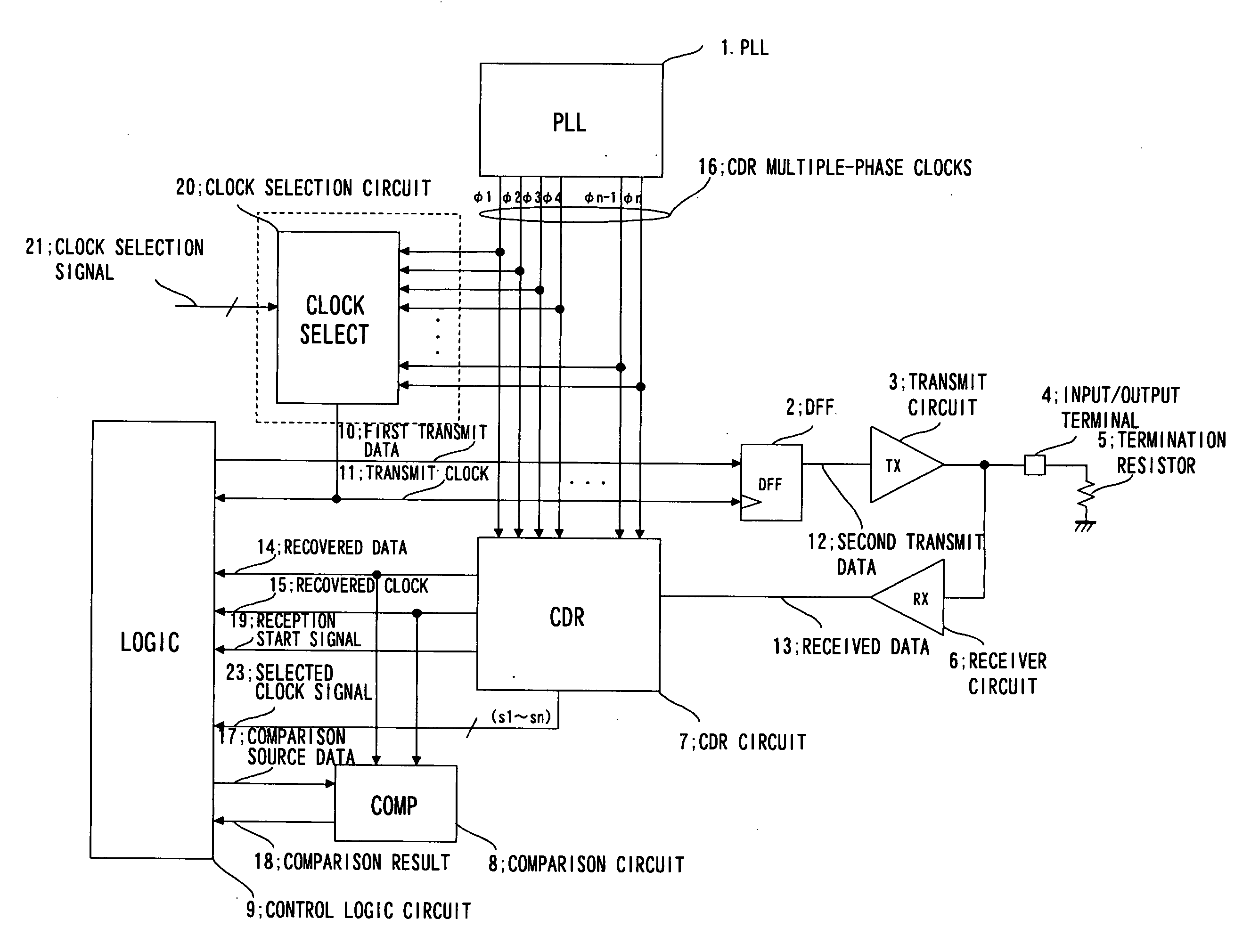Communication device
a communication device and loopback technology, applied in the direction of digital transmission, pulse automatic control, synchronisation transmitter, etc., can solve the problems of inability to test clock connections and all circuits within the cdr circuit, and inability to detect conditions. to achieve the effect of high speed
- Summary
- Abstract
- Description
- Claims
- Application Information
AI Technical Summary
Benefits of technology
Problems solved by technology
Method used
Image
Examples
first embodiment
[0073]FIG. 1 is a diagram showing a configuration of the present invention. Referring to FIG. 1, this embodiment includes the PLL circuit 1 (which is an analog PLL), a D-type flip-flop (DFF) 2, a transmit circuit 3 (which is a driver), the input / output terminal 4, a termination resistor 5, the receiver circuit 6 (which is a receiver), the CDR circuit 7, the comparison circuit 8, and a control logic circuit 9 that controls the test. This embodiment further includes the clock selection circuit 20 that receives the multiple-phase clocks 16 output from the PLL 1, selects one of the multiple-phase clocks 16 (of n-phase clocks φ1 to φn in FIG. 1) according to the clock selection signal 21 input from outside, and outputs the selected clock as the transmit clock 11.
[0074] From the PLL 1, the clock signals (referred to as “CDR multiple-phase clocks”) 16 with phases thereof being different to one another are supplied to the CDR circuit 7.
[0075] One of the clock signals having a certain phase...
second embodiment
[0106] In the present invention, shown in FIG. 3, the recovered clock 15 selected by the CDR circuit 7 according to the clock selection signal 21 depends on the transmit circuit delay time (tTx) and the receiver circuit delay time (tRx). Thus, the recovered clock 15 is not uniquely determined. For this reason, when the test is conducted, a state of the second selected clock signal 24 with respect to the clock selection signal 21 needs to be determined in advance. That is, when the clock signal with a certain phase among the multiple-phase clocks 16 is selected at the clock selection circuit 20 as the transmit clock 11, based on the clock selection signal 21, it is necessary to determine in advance which of the second selected clock signal 24 (constituted from the signals t1 to tn) goes HIGH, using measurement or the like.
third embodiment
[0107] On the other hand, in the present invention, as described above, when the fourth-phase clock φ4 of the multiple-phase clocks 16 is selected as the transmit clock 11, selection of the first-phase clock φ1 by the CDR circuit as the recovered clock 15 is managed by the second counter circuit 26, for example.
[0108] In the third embodiment of the present invention, by performing clock input just corresponding to the phase of the clock signal selected by the clock selection circuit 20 before a result of the selection of the recovered clock 15 by the CDR circuit 7 is determined, the test can be always started from the same state.
[0109] According to each of the embodiments described above, clock connections and all circuits within the CDR circuit can be tested at a high speed in an approach of the loopback test. Further, a failure in the clock selection circuit can also be detected.
[0110] Further, according to the third embodiment of the present invention, the test for detection of...
PUM
 Login to View More
Login to View More Abstract
Description
Claims
Application Information
 Login to View More
Login to View More - R&D
- Intellectual Property
- Life Sciences
- Materials
- Tech Scout
- Unparalleled Data Quality
- Higher Quality Content
- 60% Fewer Hallucinations
Browse by: Latest US Patents, China's latest patents, Technical Efficacy Thesaurus, Application Domain, Technology Topic, Popular Technical Reports.
© 2025 PatSnap. All rights reserved.Legal|Privacy policy|Modern Slavery Act Transparency Statement|Sitemap|About US| Contact US: help@patsnap.com



